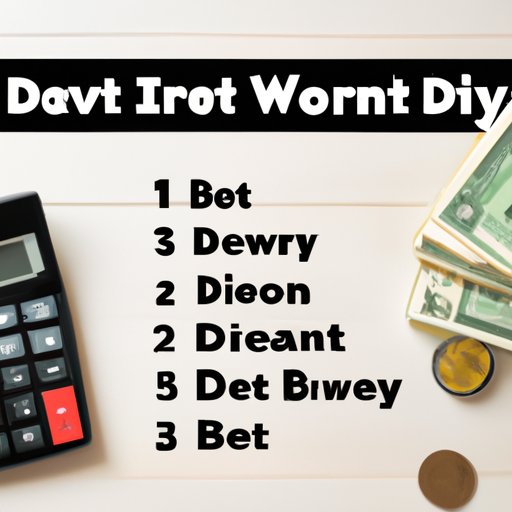
Introduction
Borrowing money is a common problem faced by many people at some point in their lives. Whether it’s for unexpected emergencies or planned expenses, sometimes we need to borrow money in order to make ends meet. However, borrowing money can also lead to debt if not done properly. It’s important to explore different options for borrowing money and choose the best one for your financial situation in order to avoid falling into debt. This article will provide a comprehensive guide to different ways of borrowing money without going into debt.

7 Smart Ways to Borrow Money Without Going Into Debt
What does it mean to borrow money without going into debt? It means being able to borrow money and pay it back without accruing any interest or fees that can lead to more significant debt. Here are 7 tips for borrowing money without going into debt:
1. Peer-to-peer lending
Peer-to-peer lending is a type of online lending that allows individuals to lend money to other individuals, cutting out the traditional banking system. These loans typically have lower interest rates than traditional bank loans and can be a good option for people with good credit. Sites like Lending Club and Prosper offer peer-to-peer lending.
2. Credit unions
Credit unions are nonprofit financial institutions that offer loans to their members. They typically have lower interest rates and more flexible terms than traditional banks. If you’re not already a member of a credit union, you can find one near you at the National Credit Union Administration.
3. 0% introductory credit card offers
Some credit cards offer 0% introductory rates on balance transfers or purchases for a limited time. If you can pay off the balance before the promotional period ends, this can be an interest-free way to borrow money. Be sure to read the terms and conditions carefully and pay attention to any fees that may apply.
4. Crowdfunding
Crowdfunding is a way to raise money from a large number of people online. There are many crowdfunding sites that allow you to create a campaign and ask for donations in exchange for rewards. This can be a good option if you’re looking for a small amount of money for a specific project or cause.
5. 401(k) loans
If you have a 401(k) retirement plan, you may be able to take out a loan against your balance. This can be a low-interest way to borrow money, but it’s important to remember that you’ll be reducing your retirement savings and could face penalties if you can’t repay the loan.
6. Home equity loans or lines of credit
If you own a home, you may be able to borrow against the equity you’ve built up through a home equity loan or line of credit. These loans typically have lower interest rates than unsecured loans, but they also come with the risk of losing your home if you can’t repay the loan.
7. Gig economy jobs
If you have a skill or service to offer, you can make some extra money by working in the gig economy. Platforms like Uber, Lyft, and Taskrabbit allow you to earn money on your own schedule. Just be sure to factor in any expenses, like gas for your car, when calculating your actual earnings.
5 Alternative Options for Borrowing Money If You Have Bad Credit
Having bad credit can make borrowing money more difficult, but there are still options available. Here are 5 alternative options for borrowing money if you have bad credit:
1. Online lenders
There are many online lenders that specialize in loans for people with bad credit. These loans typically have higher interest rates and fees than traditional loans, so be sure to read the terms and conditions carefully.
2. Credit counseling
Some nonprofit credit counseling agencies offer low-interest loans to people with bad credit. They can also provide financial education and budgeting advice to help you get back on track.
3. Payday alternative loans
Some credit unions and banks offer payday alternative loans, which are small, short-term loans with lower interest rates than traditional payday loans. These loans are designed to help people avoid falling into a debt trap.
4. Borrowing from friends or family with good credit
If you have friends or family members with good credit, they may be willing to lend you money at a lower interest rate than you would get from a traditional lender. Just be sure to have a written agreement in place to avoid any misunderstandings.
5. Secured credit cards
If you can’t qualify for a traditional credit card, you may be able to get a secured credit card. These cards require a security deposit that becomes your credit limit. Using a secured credit card responsibly can help rebuild your credit over time.
The Pros and Cons of Borrowing Money from Family and Friends
Borrowing from family and friends is a common solution, but it also comes with its own set of pros and cons. Here are some of the pros and cons of borrowing from family and friends:
Pros:
- No interest or fees
- Flexible repayment terms
- Emotional support from loved ones
Cons:
- Potential damage to relationships
- Lingering guilt or obligation
- No legal protection or formal agreement
How to Choose the Best Personal Loan for Your Financial Needs
A personal loan is a good solution if you need to borrow a larger amount of money. Here’s how to evaluate personal loan options to choose the best one for you:
- Check your credit score and history
- Compare interest rates and fees
- Read reviews and check the lender’s reputation
- Understand the repayment terms and penalties
- Consider whether a secured or unsecured loan is right for you
The Dos and Don’ts of Using Credit Cards to Borrow Money
Credit cards can be a good option for borrowing money if used responsibly. Here are some dos and don’ts for using a credit card to borrow money:
Dos:
- Choose a card with a low interest rate or 0% introductory offer
- Pay more than the minimum payment each month
- Keep your credit utilization ratio below 30%
- Use rewards to offset the cost of borrowing
Don’ts:
- Max out your credit card limit
- Miss payments or pay late
- Use cash advances, which often have higher fees and interest rates
- Use credit cards to fund a lifestyle you can’t afford
Putting Your Assets to Work: Secured Loans Explained
A secured loan is a loan that’s backed by collateral, such as a car or home. Here’s how secured loans work:
- You put up collateral to secure the loan
- If you can’t repay the loan, the lender can seize the collateral
- Secured loans typically have lower interest rates than unsecured loans
- You’ll need to have a good credit score and enough income to qualify for a secured loan
What You Need to Know About Payday Loans Before Borrowing Money
Payday loans are short-term loans with high interest rates and fees. Here’s what you need to know before choosing a payday loan:
- Payday loans can be a debt trap, with many borrowers getting stuck in a cycle of debt
- Payday loans typically have interest rates of 400% or more
- Payday loans can lead to overdraft fees and bounced checks
- Consider other options before choosing a payday loan, such as a payday alternative loan or credit counseling
Conclusion
Borrowing money can be a stressful experience, but it doesn’t have to lead to debt. By exploring different options for borrowing money and choosing the best one for your financial situation, you can borrow money without going into debt. Remember to read the terms and conditions carefully, compare interest rates and fees, and use credit responsibly. Good luck!
Suggestions for further reading or resources:




